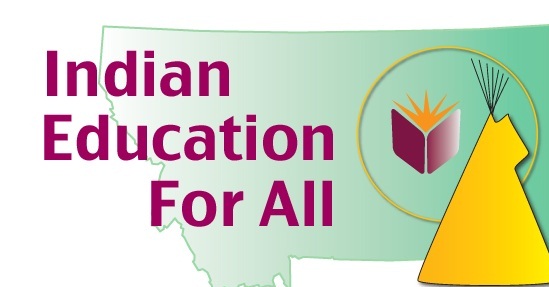
Throughout the United States, public school students usually have very little exposure to American Indian histories and cultures. Montana may be the exception. In Montana, all students in all grades and in all subjects are to be exposed to information about Montana’s Indian nations. This all started when the state adopted a new constitution in 1972. The constitution states:
“The State recognizes the distinct and unique cultural heritage of the American Indians and is committed in their educational goals to the preservation of their cultural integrity”
Rick Champoux, one of the delegates who helped craft the new constitution, stated:
“Are we to tell the Indian people that their history has no place in our schools?…that their ways, their governments were wrong and that they must accept ours, because ours are better? Or, will we help them to retain their ethnic identify and make their adaptations as Americans? If there is ever to be a solution to the Indian problem in this county, it will come about when our educational system provides the knowledge which is needed to understand and respect the cultural differences between us and the state helps to preserve and protect their cultural integrity.”
Source: http://www.mtiea.org/downloads…
In 1999, the Montana legislature followed up on the constitutional mandate by passing the Indian Education for All Act which states that:
every Montanan, whether Indian or non-Indian, be encouraged to learn about the distinct and unique heritage of American Indians in a culturally responsive manner; and (b) every educational agency and all educational personnel will work cooperatively with Montana tribes or those tribes that are in close proximity, when providing instruction or when implementing an educational goal or adopting a rule related to the education of each Montana citizen, to include information specific to the cultural heritage and contemporary contributions of American Indians, with particular emphasis on Montana Indian tribal groups and governments.
In 2001, the state superintendent of public instruction signed a policy statement to recognize, honor and facilitate the implementation of Indian Education for All. In order to help teachers incorporate Indian education into the classroom, the Montana Office of Public Instruction (OPI) in consultation with the tribes has developed 7 essential understandings. Each of these is discussed below.
Essential Understanding 1:
There is great diversity among the 12 tribal Nations of Montana in their languages, cultures, histories, and governments. Each Nation has a distinct and unique cultural heritage that contributes to modern Montana.
There are several important aspects to this Understanding. First, is the reference to Nations rather than tribes. Second, the acknowledgement of twelve Nations, which include the Little Shell Chippewa who lack federal recognition. Third, the emphasis on the distinct cultural heritages: there is no generic Montana Indian.
Essential Understanding 2:
There is great diversity among individual American Indians as identity is developed, defined and redefined by entities, organizations and people. A continuum of Indian identity, unique to each individual, ranges from assimilated to traditional. There is no generic American Indian.
This one is pretty self-explanatory.
Essential Understanding 3:
The ideologies of Native traditional beliefs and spirituality persist into modern day life as tribal cultures, traditions, and languages are still practiced by many American Indian people and are incorporated into how tribes govern and manage their affairs. Additionally, each tribe has its own oral histories, which are as valid as written histories. These histories pre-date the “discovery” of North America.
In spite of two centuries of active work by Christian missionaries, including a great deal of government sponsored missionary activity and the outlawing of all Indian religions, many of the old spiritual traditions continue to be incorporated into daily life. There is much concern today among Indian people regarding the preservation and continuation of these spiritual traditions even in the face of active opposition from non-Indians.
Oral history is often misunderstood and is discounted by academics and others who are focused on the written word. Yet oral histories which have been written down, such as those in the Christian Bible, are seen as accurate. These Indian oral histories can provide insights into Indian life prior to the arrival of the Europeans.
Essential Understanding 4:
Reservations are lands that have been reserved by the tribes for their own use through treaties, statues, and executive orders and were not “given” to them. The principle that land should be acquired from the Indians only through their consent with treaties involved three assumptions:
Both parties to treaties were sovereign powers
Indian tribes had some form of transferable title to the land
Acquisition of Indian lands was solely a government matter not to be left to individual colonists
There are many people, such as former President Ronald Reagan, who have the misconception that Indians were given lands as reservations. It is important for people to understand the historical backgrounds of the lands which Montana’s Indians reserved for themselves when giving land to the American government.
Essential Understanding 5:
Federal policies, put into place throughout American history, have affected Indian people and still shape who they are today.
The history of federal Indian policies shows that these policies might be considered schizophrenic at best. There was a time when the Indian nations were considered sovereign, then the policies attempted to destroy Indian nations and assimilate individual Indians, then the policy supported Indian sovereignty, then it attempted to terminate Indian nations and remove individual Indians to the cities, and then it began government-to-government relationships with the Nations under the concept of self-determination.
Essential Understanding 6:
History is a story most often related through the subjective experience of the teller. With the inclusion of more and varied voices, histories are being rediscovered and revised. History told from an Indian perspective frequently conflicts with the stories mainstream historians tell.
In many histories of Montana, Indians are ignored, or they are lied about, or they are relegated to the nineteenth century.
Essential Understanding 7:
Under the American legal system, Indian tribes have sovereign powers, separate and independent from the federal and state governments. However, the extent and breadth of tribal sovereignty is not the same for each tribe.
The sovereignty of Indian nations is not something granted to them by the federal government: sovereignty is an ancient right which pre-dates the formation of the United States and which is recognized in the U.S. Constitution.
Conclusion:
Montana’s Indian Education for All provides a basic model which can be modified in other areas. It is important to recognize, however, that the essential understandings were developed in consultation with tribal leaders and tribal elders as well as the state’s Office of Public Instruction.

and now am so grateful I spotted it this morning.
What is happening there is encouraging.
This so hidden in what public teaching there is: